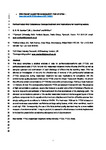Perfluorinated alkyl substances: Sewage treatment and implications for receiving waters
| dc.contributor.author | Comber, Sean | |
| dc.contributor.author | Gardner, MJ | |
| dc.contributor.author | Ellor, B | |
| dc.date.accessioned | 2021-08-09T10:20:25Z | |
| dc.date.available | 2021-08-09T10:20:25Z | |
| dc.date.issued | 2021-10-15 | |
| dc.identifier.issn | 0048-9697 | |
| dc.identifier.issn | 1879-1026 | |
| dc.identifier.other | 148391 | |
| dc.identifier.uri | http://hdl.handle.net/10026.1/17432 | |
| dc.description.abstract |
This study comprises a detailed analysis of data for perfluorooctanesulfonic acid (PFOS), and perfluorooctanoic acid (PFOA) for over 600 wastewater treatment works effluents (WwTW) as well as samples upstream and downstream of each discharge of effluent into its receiving water. This has allowed an investigation of not only the effectiveness of removal of the perfluoroalkyl substances (PFAS) compounds during wastewater treatment but also implications for compliance with the environmental quality standard (EQS) set for PFOS under the Water Framework Directive. It is shown that effluents contain concentrations of PFOS that exceed the annual average EQS by a factor between 1.1-fold and 40-fold. The corresponding factors for PFOA are between 2-fold and 22-fold. The presence of high concentrations upstream, means that between a quarter and a third of individual effluents are found to reduce the concentration of fluorocarbons in the river downstream of the discharge point. The elevated concentrations upstream of the studied wastewater treatment works suggest inputs of these perfluoro compounds into the aquatic environment are ubiquitous and therefore difficult to address from simply setting permit conditions for individual WwTW. The freshwater EQS set for PFOS is based on several worst-case accumulation coefficients and large safety factors, which, when combined, result in a sub ng/L EQS. Consequently, the use of the biota derived quality standard may be a more realistic measure of environmental risk. It may be prudent, to assess the effectiveness of controls implemented in the last few years before considering widespread end-of-pipe treatment. | |
| dc.format.extent | 148391-148391 | |
| dc.format.medium | Print-Electronic | |
| dc.language | en | |
| dc.language.iso | en | |
| dc.publisher | Elsevier | |
| dc.subject | PFAS | |
| dc.subject | PFOA | |
| dc.subject | PFOS | |
| dc.subject | Removal | |
| dc.subject | Rivers | |
| dc.subject | Wastewater treatment works | |
| dc.subject | Environmental Monitoring | |
| dc.subject | Fresh Water | |
| dc.subject | Rivers | |
| dc.subject | Sewage | |
| dc.subject | Water Pollutants, Chemical | |
| dc.title | Perfluorinated alkyl substances: Sewage treatment and implications for receiving waters | |
| dc.type | journal-article | |
| dc.type | Journal Article | |
| plymouth.author-url | https://www.ncbi.nlm.nih.gov/pubmed/34412376 | |
| plymouth.volume | 791 | |
| plymouth.publication-status | Published | |
| plymouth.journal | Science of the Total Environment | |
| dc.identifier.doi | 10.1016/j.scitotenv.2021.148391 | |
| plymouth.organisational-group | /Plymouth | |
| plymouth.organisational-group | /Plymouth/Faculty of Science and Engineering | |
| plymouth.organisational-group | /Plymouth/Faculty of Science and Engineering/School of Geography, Earth and Environmental Sciences | |
| plymouth.organisational-group | /Plymouth/REF 2021 Researchers by UoA | |
| plymouth.organisational-group | /Plymouth/REF 2021 Researchers by UoA/UoA06 Agriculture, Veterinary and Food Science | |
| plymouth.organisational-group | /Plymouth/Research Groups | |
| plymouth.organisational-group | /Plymouth/Research Groups/BEACh | |
| plymouth.organisational-group | /Plymouth/Research Groups/Marine Institute | |
| plymouth.organisational-group | /Plymouth/Users by role | |
| plymouth.organisational-group | /Plymouth/Users by role/Academics | |
| dc.publisher.place | Netherlands | |
| dcterms.dateAccepted | 2021-06-07 | |
| dc.rights.embargodate | 2022-6-9 | |
| dc.identifier.eissn | 1879-1026 | |
| dc.rights.embargoperiod | Not known | |
| rioxxterms.versionofrecord | 10.1016/j.scitotenv.2021.148391 | |
| rioxxterms.licenseref.uri | http://www.rioxx.net/licenses/all-rights-reserved | |
| rioxxterms.licenseref.startdate | 2021-10-15 | |
| rioxxterms.type | Journal Article/Review |


